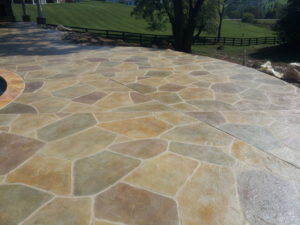 Decorative concrete is a highly recommended choice for outdoor paving nowadays. One of the most popular options is Stamped Concrete Overlays. Not only does it look so good, it is also durable enough to last for years. Although it looks something you could do yourself, it is wisest to have a professional install it for you. Effectively applying stamped concrete designs has a lot to do with timing. So, stamp it too early and the patterns won’t imprint properly. Stamp it too late and the pattern would not transfer. Here, the most significant parts of the stamping concrete process are explained to give you an overview of what takes place during an installation. Knowing exactly what goes on will definitely give you a deeper appreciation of the results and the people involved in the process.
Decorative concrete is a highly recommended choice for outdoor paving nowadays. One of the most popular options is Stamped Concrete Overlays. Not only does it look so good, it is also durable enough to last for years. Although it looks something you could do yourself, it is wisest to have a professional install it for you. Effectively applying stamped concrete designs has a lot to do with timing. So, stamp it too early and the patterns won’t imprint properly. Stamp it too late and the pattern would not transfer. Here, the most significant parts of the stamping concrete process are explained to give you an overview of what takes place during an installation. Knowing exactly what goes on will definitely give you a deeper appreciation of the results and the people involved in the process.
Installing Concrete Stamping Patterns on Existing Concrete
Damage on outdoor surfaces are expected to happen especially if these are exposed to various harmful elements, such as heat, ice, rain, and foot traffic. If the concrete is still structurally sound, meaning there aren’t any major cracks or scaling damage on it, it is highly recommended to apply an overlay and then using concrete stamps to beautify it further.

- First off, the existing concrete slab is power washed to remove dirt and loose cement.
- Any fine, hairline cracks are filled with an epoxy filler to make sure that the overlay is applied on a fairly smooth surface.
- A primer coat is mixed and applied to encourage the overlay to adhere efficiently.
- The stamp overlay mix is prepared and applied on the old concrete. This is usually applied at about 0.25 to 0.75 of an inch thickness only so as not to create a major impact over the height of the floor.
- Once the overlay is dense enough, a releasing agent is sprayed lightly on it so as to encourage the concrete to stay in place and not adhere to the mat when time comes to stamp concrete patterns.
- Concrete stamp patterns are now placed on top of the overlay and pounded lightly on the surface to make sure that the concrete follows the design and texture completely.
- The overlay is now left to dry and cure thoroughly.
- Once the surface is dry and sturdy, it can either be sweeped off of excess dirt and cement or power washed.
- Color stains can now be added using a spraying equipment or through manual hand-painting, depending on the design chosen. Cobblestone stamped concrete often uses only one gray color for the whole surface whereas a flagstone stamped concrete is more customized, each stone having its own unique color or tone.
- After the color has dried, a thin layer of acrylic coating or sealer is applied to make the color more pronounced, to add an extra sheen on the surface, and to keep it protected from harmful outdoor elements.
Read More Here:} Stamped Concrete Patterns: How is it done?
No comments:
Post a Comment